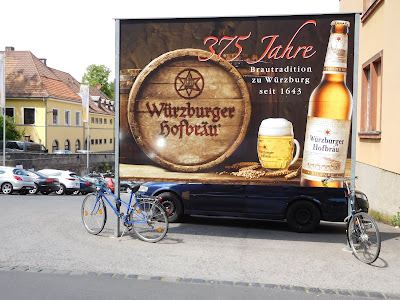The other night I made the final booking for my forthcoming trip
to the United States,
and the travel arrangements are now complete. It's been a little complicated at
times and I've had to make a few changes, but now with the last of five flights
and two train journeys, plus hotels in two different locations booked, I can
sit back and do the interesting stuff - like searching out the best bars and
breweries where I can enjoy a few beers.
I won't bore people with all the details, but basically I'm
flying into Washington Dulles, and then spending three nights in nearby Loudon
County, Virginia, at the hotel
which is hosting this year's Beer Bloggers & Writers Conference.
The conference, of course is one of two reasons for my trip;
the second being spending a few days with my sister and her husband at their
home in a small Ohio town to the south-west of Cleveland.
Once the conference has finished, I've got to travel between
the two locations, but before doing so I will be heading south-east from Loudon
for a brief visit to Richmond, on
the BBW Post-Conference trip. This will be a whistle-stop tour of some of Richmond's
finest breweries and bars.
I mentioned before that Richmond
was the Confederate State Capital during the American Civil War, but I don't think we'll be seeing much
from those times, as the city was razed to the ground by the victorious Union
forces in the closing days of the conflict. I'm certain though, that in the
intervening 153 years, Richmond
will have had plenty of time to rise from the ashes, reinvent itself, and get
brewing some amazing beers.
 |
| CC BY-SA 3.0 (https://creativecommons.org/licenses/by-sa/3.0)], via Wikimedia Commons |
 |
| CC BY-SA 3.0 (https://creativecommons.org/licenses/by-sa/3.0)], via Wikimedia Commons |
The raid took place in 1859, and Brown's objective was to
start an armed insurrection amongst local slaves. The skirmish certainly escalated
tensions and alarmed many of Virginia's slave owners, and was one of the
contributory factors which led to the secession, a year later, of the Southern
States from the Union; an event which led directly to the start of the American Civil War.
The rail-line then follows a winding route up through West
Virginia and into Maryland,
before crossing into Pennsylvania.
The train reaches Pittsburgh at
around midnight, and I had considered
leaving the train and spending the night there, before taking a Greyhound bus to my sister's the following morning. Amtrak's poor time-keeping record (more on that
later), plus the hassle of checking into a hotel in the early hours of the
morning, persuaded me it was best to stay on the train, and sleep the night
away in the comfort of my roomette.
The following morning we will be journeying through Ohio
and up towards Cleveland. I could
have asked my sister to meet me there, but as our arrival would be around 2am, it didn't really seem fair to ask her and,
as I've said already, I fancy a decent night's sleep.
The train is due in to Chicago
at 8:45, having travelled from Ohio,
across the state of Indiana and
into Illinois. In theory this
should have left ample time for me to walk across to the Greyhound bus station
and take the 11:15 service to Elyria; the nearest large town to my sister's
place. I mentioned earlier though about Amtrak's poor time-keeping, and this
somewhat threw a spanner into the works.
A friend of mine, who has travelled extensively all over the
US by rail,
told me that it is not unusual for delays of several hours to Amtrak services.
I did some checking of my own and discovered this was indeed the case. The
delays are due to the fact that Amtrak do not own any of the tracks their
trains travel over. Several large railroad companies own the majority of America's
remaining rail routes, and freight, rather than passengers, is their main
concern.
Anyone who has travelled through America cannot failed to
have been mesmerised by the sight of some of the incredibly-long freight trains,
hauled by two or sometimes even three powerful locomotives as they pass by. On
a still evening, you can hear them from my sister's house, as they emit their
ghostly whistles whilst rumbling onwards through the night.
Although they are not supposed to, the railroad companies
will normally give priority to these massive freight trains; after all they are
their bread and butter and the fees they collect from Amtrak pale into
insignificance compared to a lucrative shipment of coal, timber, iron ore etc.
Amtrak's own site indicated that delays of up to three hours are not uncommon
on the southern section between Washington
and Pittsburgh, whilst from Pittsburgh
to Chicago delays of up to 90
minutes may be experienced.
I decided to change my plans, swapping road transport for
air, and booked a flight of just one hour 20 minutes back to Cleveland.
It was considerably more expensive than what Greyhound would have charged me,
but it not only gave me a lot more "slack" time to play with at Chicago, it also saved me a bus journey of almost nine hours!
So after two days and one night's travelling, I will have
five and half days to spend with my sister and her husband. I know my
brother-in-law has booked a few days off work, and if my last visit, nearly 10
years ago, is anything to go by, there will be quite a lot of beer drinking
involved.
My brother-in-law developed a liking for decent beer during his 13 year
deployment with the USAF at Lakenheath airbase in Suffolk.
Returning to the states, with my sister in tow, some 20 years or so ago, he
managed to track down plenty of interesting local beer, and I imagine what was
a burgeoning brewing scene back in 2008, will have changed out of all
recognition.
Cleveland-based, Great Lakes Brewing are now one of the
major players locally, but there are plenty of others. One place I know we will
be visiting, is a place called the Brew Kettle. This establishment, in the
suburbs of Cleveland, acts as a
place where enthusiasts can visit in order to brew their own beer, as well as
enjoying a few of the multitude of different ales on tap at the Brew-Kettle bar and
restaurant.
The good news is that a branch of the Brew Kettle has opened
in the town, where my sister and her
family reside. We can now just stroll down the road, and all enjoy a few
excellent local beers, without any of us having to moderate their consumption
for the drive back.
I've left the "there and back" part of the trip
until last, but it's no less interesting. I'll be flying with Icelandair, who operate out of Gatwick,
and fly to both Washington Dulles and Cleveland, via Reykjavik.
On the outward journey it's significantly cheaper for me to break my journey,
and when I say "significantly," I mean virtually half-price!
I'll therefore spending a night and a morning in the
Icelandic capital - not the cheapest place for a beer, but another destination
to cross off the list.
A quick final word about the photos. Most were taken on my previous visit to America, back in 2008,and several of them relate to places described in the narrative.
A quick final word about the photos. Most were taken on my previous visit to America, back in 2008,and several of them relate to places described in the narrative.
















































